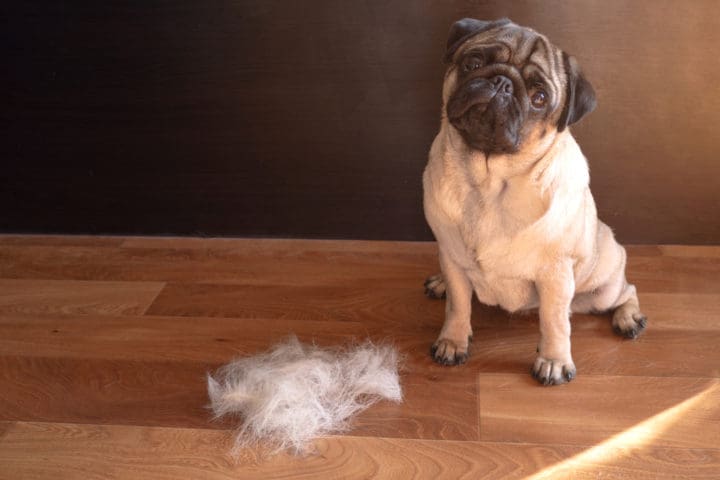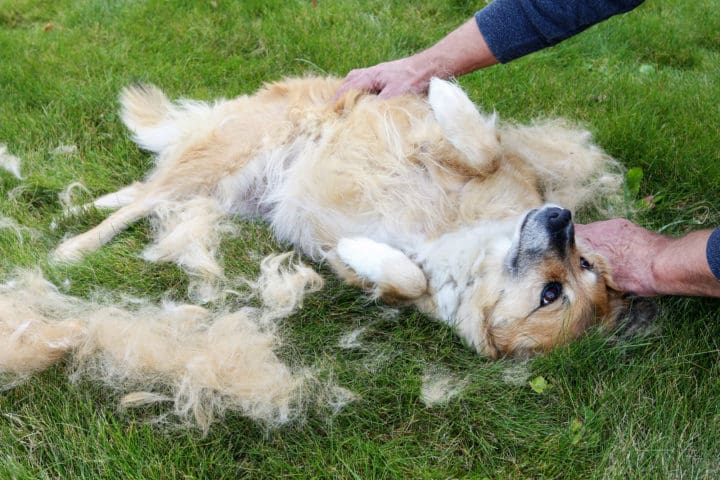How to Reduce Dog Shedding
A Cleaner Home & Happier You: Reduce Your Dog's Shedding
Most healthy dogs do not shed hair all year round, and they should not constantly scratch or have a bad odor. Although you cannot completely prevent your dog from shedding, there are ways to minimize it. This will help you keep your clothes and furniture free of fur. I used to have a dog that shed hair all year round. He also had a slight odor, and he constantly itched and scratched. His itching and scratching never seemed to stop. We initially didn't think it was a big problem. However, we later realized that it was driving us and our poor dog crazy! We hope that you find this post on how to reduce dog shedding useful.

Image from Depositphotos
From Poodles to Pugs : How to Reduce Dog Shedding
Brushing
- Regular brushing: This is the single most effective way to control shedding. Brushing regularly (daily for some breeds) removes loose hair before it falls on your floor. Brush your dog at least once a week, and more often during shedding seasons (spring and fall). Choose the right brush for your dog's coat type:
- Bristle brushes: Good for all coat types, especially short-haired dogs.
- Slicker brushes: Ideal for long-haired dogs prone to mats and tangles.
- Undercoat rakes: Effective for removing loose fur from double-coated breeds.
- Brush thoroughly: Brush from the skin outwards, reaching all areas of the body. Brush with the direction of hair growth, starting from the head and working your way down. This removes loose hair, stimulates circulation, and distributes natural oils for a healthy coat.
- Brushing your dog: The type and frequency of brushing depend on your dog's breed and coat type.
- Short-haired dogs: Brush 1-2 times a week with a bristle brush or rubber curry comb.
- Long-haired dogs: Brush daily with a slicker brush to remove mats and tangles, followed by a bristle brush to distribute oils.
- Double-coated dogs: Brush daily during shedding seasons (spring and fall) with an undercoat rake to remove loose fur from the undercoat.
The Pros and Cons Of Having a Cat
Bathing
- Frequency: Occasional baths (frequency depends on breed and activity level) remove loose hair and dirt. Don't over-bathe your dog, as it can dry out their skin and worsen shedding. The ideal frequency depends on your dog's breed, coat type, and activity level. Use a gentle dog shampoo and avoid over-bathing, which can dry out the skin and worsen shedding. Consult your veterinarian for guidance.
- De-shedding shampoo: Consider using a de-shedding shampoo formulated to loosen and remove loose fur. Consult your vet first, especially for sensitive pups.
- Thorough rinsing and drying: Ensure all shampoo residue is rinsed away, and towel dry your dog thoroughly. You can also use a blow dryer on a low heat setting to further remove loose hair.
Diet & Nutrition
- High-quality food: A balanced diet rich in omega-3 fatty acids and other essential nutrients can improve your dog's skin and coat health, reducing shedding. Choose a high-quality dog food appropriate for your dog's age, breed, and activity level.
- Supplements: Consult your veterinarian about adding omega-3 fatty acid supplements to your dog's diet if needed.
For me, it wasn't enough just to stop it, I wanted to know what the problem was and why he was so itchy. Why was Buckley itching so much? I didn't want to mask his symptoms, I wanted to cure the problem or at least understand it a little better. Dog food (or at least the commercial kind) is cooked at very high temperatures which destroys the nutrients that your dog needs to be healthy. Most pets walk around in a slight state of malnourishment, missing out on things such as vitamins, minerals, digestive enzymes, beneficial bacteria plus essential fatty acids. Excessive shedding, itchy skin, and a smelly dog are usually signs of a nutritional deficiency.

Image from Depositphotos
Hydration
It is important to maintain proper hydration for your dog. Dehydration can contribute to shedding. Ensure your dog has access to fresh water throughout the day.
Manage Stress, Allergies, and Underlying Medical Issues
Allergies, hormonal imbalances, and other health problems can cause excessive shedding. Stress can contribute to excessive shedding. See your vet if you suspect a medical cause. Address any underlying issues with your veterinarian.
Invest in Good Cleaning Tools
Lint rollers, handheld vacuums, and furniture covers can help manage scattered fur.
Acceptance
Remember, some shedding is natural. Embrace your furry friend's coat and the love (and fur) they bring!
How to Become the Ultimate Pet Parent
More Tips
- Vacuum regularly: Use a vacuum cleaner with a pet hair attachment to remove shed fur from your home.
- Cover furniture: Invest in throws or covers for furniture to minimize hair accumulation.
- Consider de-shedding tools: Special tools like Furminators can help remove loose fur during shedding seasons.
- Rule out medical causes: Excessive shedding can sometimes be a symptom of underlying health issues. If you notice a sudden increase in shedding, consult your vet.
Just in case you are curious or are just as in love with our dog as we are, you may want to consider checking out the American Brittany Rescue. This is where we adopted Buckley from and we have never been sorry. We gave a home to a dog who was abandoned and he has been a great pal to our entire family.
Effective Strategies for Reducing Dog Shedding
Every dog is different, so what works for one might not work for another. Experiment with different strategies to keep your furry friend healthy and your home fur-free. By following these tips, you can significantly reduce dog shedding and maintain a cleaner home environment. Always prioritize your dog's health and well-being over minimizing shedding. Consult your veterinarian for personalized advice tailored to your dog's breed and specific needs. We hope that you find this How to Reduce Dog Shedding post valuable. Good luck!
WE LOVE OUR FURRY FRIENDS ~ More for Dogs:

7 Benefits of Having a Pet
You May Also Like

Thanks for the info., our Oakley Faith is itchy a lot. I am totally going to have my hubs look into this.
Hey, I have a brittany too and she THRIVES on dinovite! I use the carnoyum from their company. When I used the “solution center” I answered a few questions on their website and the products carnoyum and supromega popped up. The first time I ordered, they were giving away shampoo so I got the peppermint one which we used right away (it was just 2 ounces sample).
Benny is itch-free, stink-free and shed-free now, so we love him even more LOL! Actually, it does make him easier to love. The kids now lay on the floor to watch movies so Benny can lay with them on their blankets and pillows. Before dinovite, poor Benny was the only one on the floor during movie nights!
I’ll have to check that product out. I thought I had tried everything–Bella, my cocker, itches nonstop and Bailey, the chihuahua mix, sheds enough for about 5 dogs–but I have never heard of Dinovite.
There are so many different things that can affect how much a dog sheds. From the food and diet, exercise, grooming. We try to combine use of a deshedding tool, bathing, and brushing. It has help tremendously on cutting back the amount of hair we find on the floor, furniture, bed, in our vehicles, in food lol, and just about everywhere
The folks at Dinovite are super nice too- I got some of the shampoo, and it really is great smelling. We adopted a black dog almost two years ago. Odin is a border collie/aus shepherd mix but is black with a small patch of white on his chest. He is my walking buddy and hubby calls him velcro because he is never very far away from me 🙂
Did you know black, larger breeds (or mixes) above 30# are the most often euthanized ? People dont adopt them as quickly.